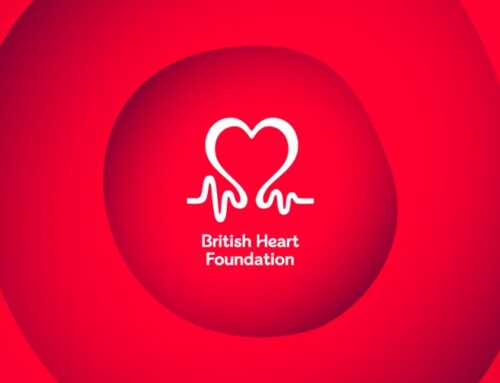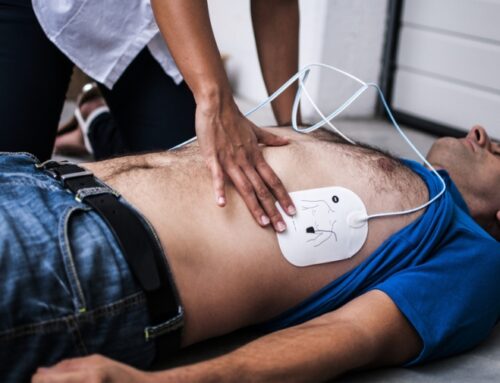In the modern workplace, it’s easy to drown in tasks, targets, and to-do lists, blinding us to the more sobering statistics that, sadly, also occupy our work environments. One such statistic is the alarming rate at which cardiac arrests occur in UK workplaces and the potentially avoidable loss of lives they represent.
This article dives into the crucial matter of cardiac emergencies in the workplace and highlights the pivotal role that CPR and defibrillation play in averting disaster. It will also explore how workplaces can ensure early defibrillation and resuscitation during cardiac emergencies.
Understanding Workplace Cardiac Arrests (WCAs)
According to a study by the British Heart Foundation, over 30,000 out-of-hospital cardiac arrests occur in the UK every year, with a significant proportion (15%) happening within the work setting.
Despite this high rate of WCAs, it is not currently a legal requirement for all employers to have a fully trained first aider who is competent in CPR and defibrillation. There is also no legal requirement for an employer to provide a defibrillator.
This is a shortcoming that we at WEL Medical profoundly disagree with, as failure to provide such lifesaving skills and resources is consistently resulting in a tragic loss of life throughout the UK.
Which Industries Are Most at Risk?
Studies show that those working in industries involving strenuous physical activities, working at heights, or handling heavy machinery are at a higher risk of cardiac arrest. However, even the seemingly safe haven of office work is not immune, with stress, high-pressure deadlines, and sedentary lifestyles known to be contributing factors to heart complications.
According to an article published in the Observer, other jobs that can present a heightened risk of cardiac arrest include personal care and service, management roles, and education and training roles. This reinforces the indiscriminate nature of cardiac arrests – they can occur anywhere and at any time, so it’s crucial for employees and employers to be as well prepared as possible.
What are the Benefits of CPR Training for Employees?
CPR is not a complex medical procedure that only seasoned healthcare professionals can perform. It’s a set of simple yet crucial interventions that keep oxygen flowing to the victim’s vital organs until professional medical help arrives.
When businesses invest in CPR training, they are empowering their staff with potentially lifesaving skills. CPR training improves employees’ confidence and can lead to a more proactive response in critical situations. It also fosters a culture of preparedness and care within the organisation.
Why is AED Training Important in the Workplace?
As many readers will already know, automated external defibrillators (AEDs) are designed to deliver an electric shock to the heart, restoring its rhythm in cases of arrhythmias and other sudden cardiac arrests causes.
The deployment of AEDs is mission-critical. In instances of cardiac arrest, the quicker the defibrillator is used, the higher the likelihood of survival. Hence, the strategic placement of AEDs in the workplace, along with regular inspection and maintenance, is of the utmost importance.
How Can Workplaces Properly Implement CPR and AED Training?
To truly integrate lifesaving measures like CPR and defibrillation into the fabric of the work environment, businesses need to take a holistic approach, developing and executing a comprehensive AED program and CPR strategy.
We advise that training should not be restricted to specific individuals; CPR skills should be disseminated company-wide. This approach spreads the safety net wider, ensuring that regardless of where a cardiac event occurs, there is someone nearby who can spring into action.
Ensuring Regular Refreshers
In the past, we’ve spoken about how crucial refresher training is to ensure proficiency in CPR and AED. Studies show that, without proper refresher training, the retention of CPR training skills is poor, meaning that helping your staff stay on top of their BLS skills is non-negotiable for strengthening the chain of survival.
Mapping and Maintaining AEDs in the Workplace
While ensuring that your employees are skilled in the use of an AED, it’s equally important that they’re able to access a fully operational defibrillator in an emergency situation. This means that providing clear, easy-to-remember guidance on AED location within the workplace is a must.
It’s also crucial to ensure you’re taking the proper steps to maintain your AED to ensure it can save a life in an emergency situation. Regular checks and maintenance schedules for AEDs should be integrated with existing safety protocols. This ensures that in the worst-case scenarios, businesses never find themselves with a non-functional device.
A Culture of Transparency
When it comes to understanding why AEDs and CPR training are so important in the workplace, a culture of transparency and self-reflection is vital. Organisations should not shy away from examining incidents and the ensuing response, regardless of the outcome. Post-event analyses can uncover issues in the system that, if corrected, could better prepare for future emergencies.
Accepting that your workplace has shortcomings regarding its capacity to respond to a cardiac arrest is a huge step in overcoming these challenges and creating a safer, healthier, and happier work environment.
Do You Want to Strengthen the Chain of Survival in the Workplace?
At WEL Medical, we’re motivated by the prospect of saving lives. That’s why we prioritise AED solutions that are simple and easy to use for everyone. The NFK200 AED is a testament to this ethos, with its unmatched simplicity and outstanding features.
Above: WEL Medical’s NFK200 AED
Its resilient build is IP42-rated, offering solid protection against dust and foreign objects, while clear visual and calming verbal instructions take you through every step of defibrillation. It’s also perfect for use in conjunction with CPR, as it offers a CPR Step Detection Indicator to increase the effectiveness of your CPR.
You can find out more about our full range of defibrillators here, or contact our team for more information.








